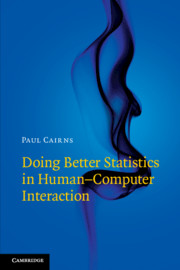Book contents
- Frontmatter
- Dedication
- Contents
- Figures
- Tables
- Acknowledgements
- Getting Started
- Part I Why We Use Statistics
- Part II How to Use Statistics
- 5 Planning Your Statistical Analysis
- 6 A Cautionary Tail: Why You Should Not Do a One-Tailed Test
- 7 Is This Normal?
- 8 Sorting Out Outliers
- 9 Power and Two Types of Error
- 10 Using Non-Parametric Tests
- 11 A Robust t-Test
- 12 The ANOVA Family and Friends
- 13 Exploring, Over-Testing and Fishing
- 14 When Is a Correlation Not a Correlation?
- 15 What Makes a Good Likert Item?
- 16 The Meaning of Factors
- 17 Unreliable Reliability: The Problem of Cronbach’s Alpha
- 18 Tests for Questionnaires
- Index
16 - The Meaning of Factors
from Part II - How to Use Statistics
Published online by Cambridge University Press: 26 January 2019
- Frontmatter
- Dedication
- Contents
- Figures
- Tables
- Acknowledgements
- Getting Started
- Part I Why We Use Statistics
- Part II How to Use Statistics
- 5 Planning Your Statistical Analysis
- 6 A Cautionary Tail: Why You Should Not Do a One-Tailed Test
- 7 Is This Normal?
- 8 Sorting Out Outliers
- 9 Power and Two Types of Error
- 10 Using Non-Parametric Tests
- 11 A Robust t-Test
- 12 The ANOVA Family and Friends
- 13 Exploring, Over-Testing and Fishing
- 14 When Is a Correlation Not a Correlation?
- 15 What Makes a Good Likert Item?
- 16 The Meaning of Factors
- 17 Unreliable Reliability: The Problem of Cronbach’s Alpha
- 18 Tests for Questionnaires
- Index
Summary
Factor analysis is quite regularly seen in HCI to validate questionnaires, particularly those used to measure user experience. This chapter describes and illustrates the process of developing a questionnaire to measure a particular concept, starting from item generation through to factor analysis and interpretation. It introduces bifactor analysis as a more recent development in factor analysis that could help the interpretation of questionnaires made up of multiple factors.
Keywords
- Type
- Chapter
- Information
- Doing Better Statistics in Human-Computer Interaction , pp. 186 - 203Publisher: Cambridge University PressPrint publication year: 2019

